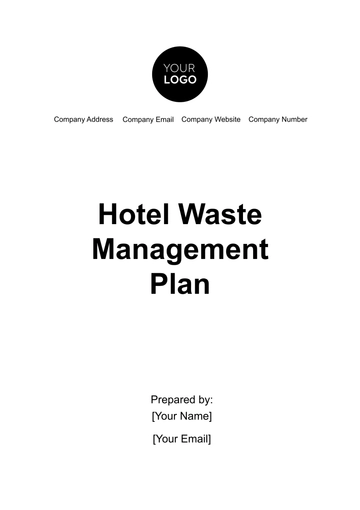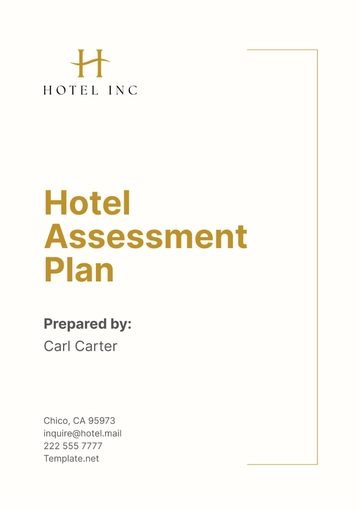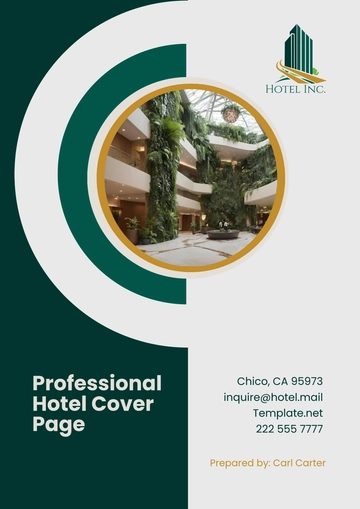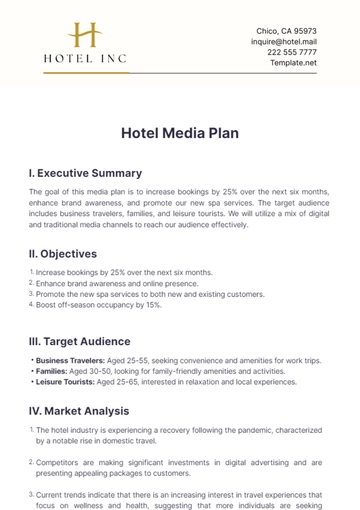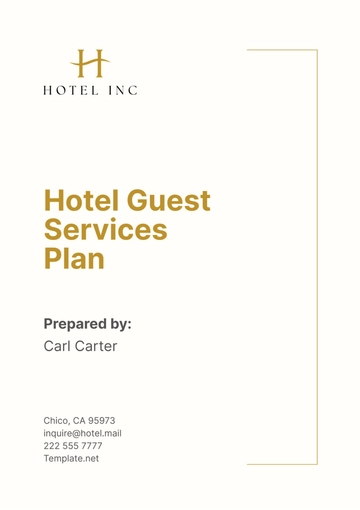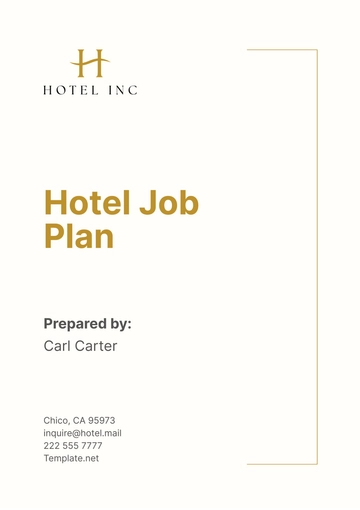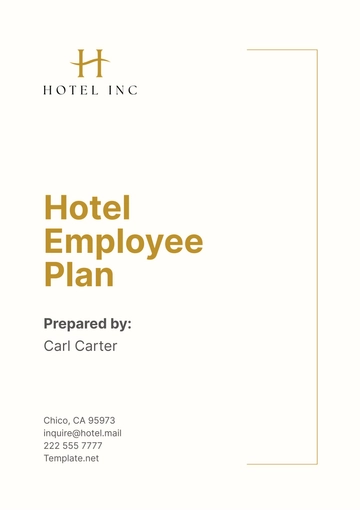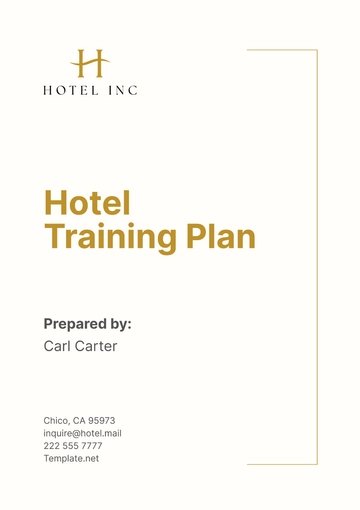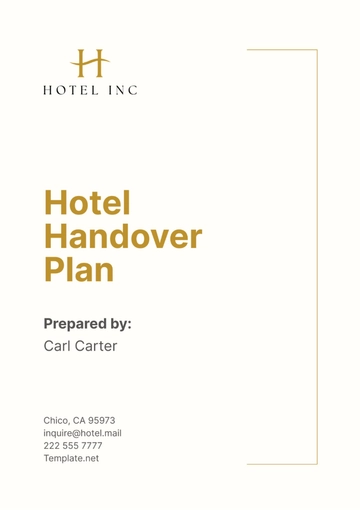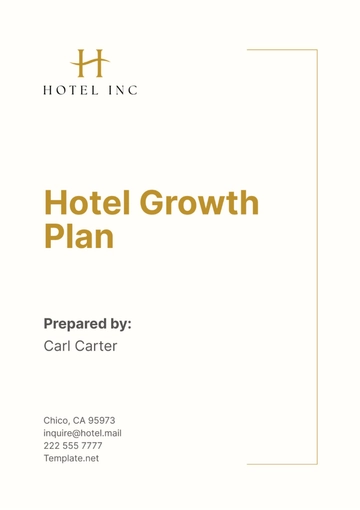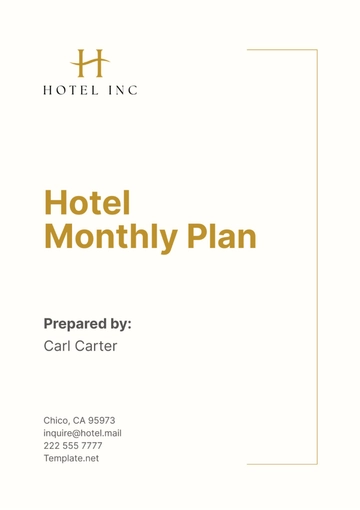Free Hotel Growth Plan
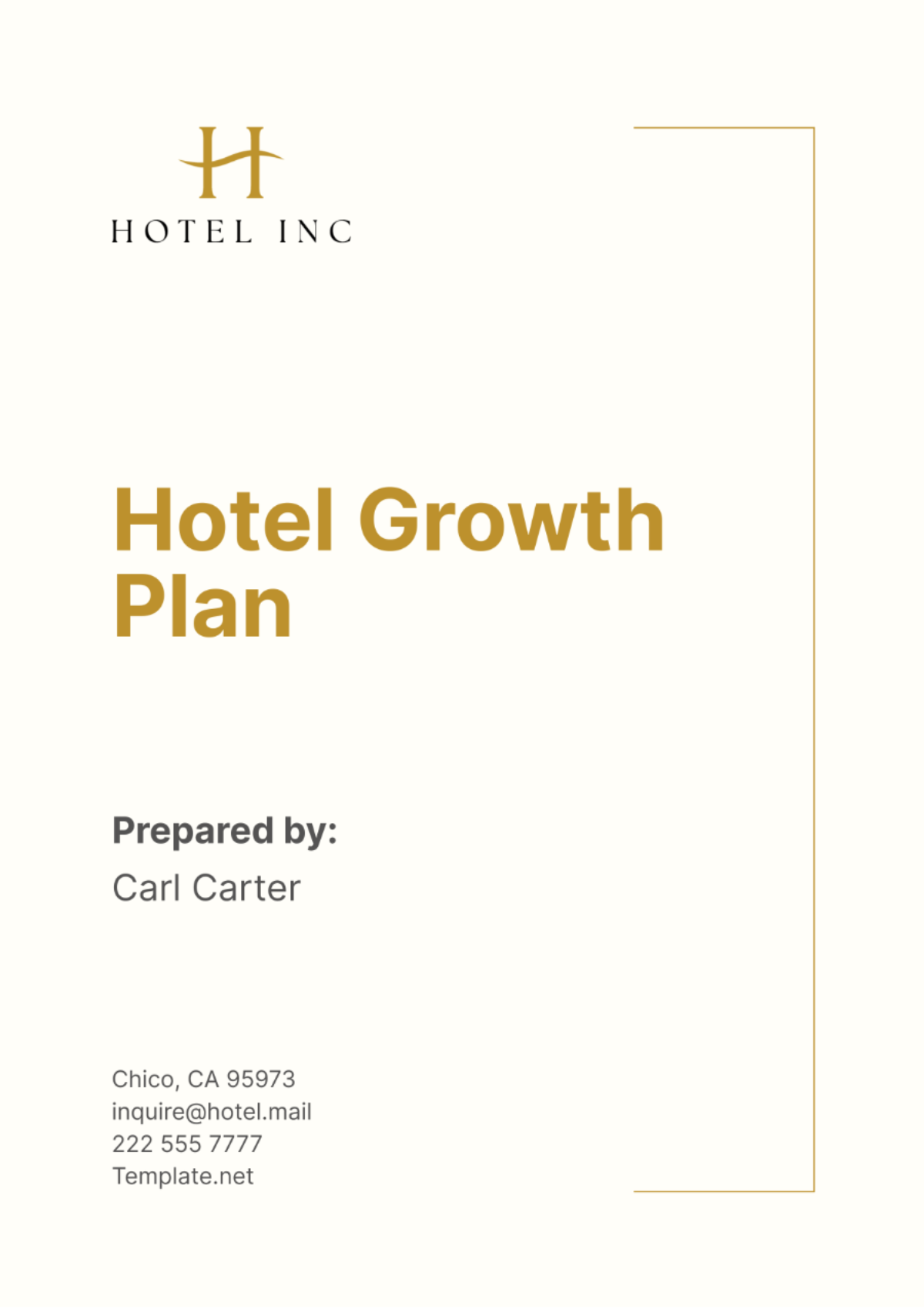
I. Executive Summary
The Hotel Growth Plan is designed to outline a comprehensive strategy towards amplifying the market presence and profitability of [Your Company Name]. Given the dynamic and competitive nature of the hospitality industry, this plan provides actionable insights into key areas such as market expansion, service enhancement, and customer satisfaction. The primary goal is to establish a clear and structured approach that ensures sustainable growth while addressing the evolving needs of our guests and the market.
In the following sections, detailed analysis and strategic recommendations based on [Your Company Name]'s current status and future potential are presented. This plan will serve as a roadmap to guide our efforts in achieving sustainable growth and securing a competitive edge in the industry. Through a combination of innovative strategies, targeted investments, and operational excellence, we aim to enhance our brand presence and deliver exceptional value to our stakeholders.
II. Market Analysis
Understanding the market dynamics is crucial for the growth of [Your Company Name]. Extensive research has been conducted to identify current trends, demand drivers, and the competitive landscape. This helps in crafting a strategy that aligns with the needs and preferences of the target audience. The key findings from the market analysis provide a foundation for our strategic planning and decision-making processes.
Key Findings from Market Analysis
Growing Demand for Personalized and Experiential Travel:
Travelers are increasingly seeking unique, personalized experiences that go beyond traditional accommodations.
There is a rising interest in local culture, cuisine, and activities that provide an immersive travel experience.
Increasing Use of Technology in Enhancing Guest Experience:
Technological advancements are playing a significant role in improving operational efficiency and guest satisfaction.
Innovations such as mobile check-ins, smart room controls, and virtual concierge services are becoming standard expectations.
Shifting Preferences Towards Eco-Friendly and Sustainable Accommodations:
Sustainability is no longer just a trend but a necessity for modern travelers.
Eco-conscious guests prefer hotels that implement green practices such as energy efficiency, waste reduction, and sustainable sourcing.
Strong Competition from Both Established Hotels and New Entrants:
The hospitality market is highly competitive, with both well-established brands and new entrants vying for market share.
Differentiation through unique value propositions and superior guest experiences is essential for standing out.
III. Strategic Objectives
To achieve our growth aspirations, [Your Company Name] has identified several key strategic objectives. These objectives are designed to build upon our strengths and address the opportunities and challenges identified in the market analysis.
Strategic Objectives
Expand Our Presence in Key Geographic Markets:
Identify high-potential markets and develop targeted expansion plans.
Leverage local partnerships and insights to effectively enter and grow in new regions.
Enhance the Guest Experience Through Innovation and Technology:
Invest in cutting-edge technologies to streamline operations and elevate the guest experience.
Continuously improve our service offerings through feedback-driven innovation.
Increase Brand Loyalty and Customer Retention:
Develop loyalty programs that reward repeat guests and encourage long-term relationships.
Personalize marketing efforts to engage customers based on their preferences and behaviors.
Invest in Sustainable Practices and Eco-Friendly Initiatives:
Implement green practices across all aspects of hotel operations.
Achieve certifications and recognition for our commitment to sustainability.
Strengthen Partnerships and Strategic Alliances:
Forge alliances with key stakeholders in the industry, including suppliers, travel agencies, and local businesses.
Collaborate on joint promotions and initiatives that enhance our market presence.
IV. Implementation Plan
The success of the Hotel Growth Plan hinges on effective implementation. A well-defined action plan with clear responsibilities and timelines has been developed to ensure our strategic objectives are met.
Implementation Steps
Market Expansion:
Identify and Enter New Markets: Utilize data-driven insights to pinpoint high-growth regions.
Local Partnerships: Collaborate with local businesses and stakeholders to facilitate market entry.
Technology Integration:
Invest in Advanced Technological Solutions: Implement mobile check-ins, smart room controls, and other innovations.
Enhance Guest Experience: Use technology to offer personalized services and streamline operations.
Customer Engagement:
Develop Loyalty Programs: Introduce tiered loyalty programs with exclusive benefits for repeat guests.
Personalized Marketing Strategies: Use data analytics to create targeted marketing campaigns.
Sustainability Initiatives:
Implement Green Practices: Adopt energy-efficient systems, reduce waste, and source sustainably.
Certifications: Pursue certifications such as LEED to validate our sustainability efforts.
Partnerships:
Forge Strategic Alliances: Collaborate with travel agencies, local businesses, and suppliers.
Expand Network and Resources: Utilize partnerships to enhance our service offerings and reach.
Action Plan Table
Objective | Action Steps | Timeline | Responsible Party |
|---|---|---|---|
Expand Presence in Key Markets | Identify high-potential markets | Q1 2050 | Market Research Team |
Develop targeted expansion plans | Q2 2050 | Business Development | |
Enhance Guest Experience | Invest in advanced technology solutions | Q1-Q2 2050 | IT Department |
Implement mobile check-ins, smart room controls | Q3 2050 | Operations Team | |
Increase Brand Loyalty | Develop and launch loyalty programs | Q2 2050 | Marketing Team |
Personalize marketing efforts | Ongoing | Customer Relations | |
Invest in Sustainable Practices | Implement green practices across operations | Q1-Q4 2050 | Sustainability Team |
Pursue certifications (e.g., LEED) | Q3 2050 | Facilities Management | |
Strengthen Partnerships | Forge alliances with key stakeholders | Q1-Q4 2050 | Partnership Manager |
Collaborate on joint promotions | Ongoing | Marketing Team |
V. Financial Projections
Accurate financial projections are essential for planning and securing investments. This section provides a detailed financial forecast for [Your Company Name] over the next three to five years, including projected revenues, expenses, and profit margins.
Summary of Key Financial Indicators
The following table summarizes the key financial indicators for the next five years, providing a clear overview of projected revenue, operating costs, and net profit. These projections are based on current market trends and the strategic initiatives outlined in this growth plan.
Year | Projected Revenue (USD) | Operating Costs (USD) | Net Profit (USD) |
|---|---|---|---|
2050 | $15,000,000 | $10,000,000 | $5,000,000 |
2051 | $17,000,000 | $11,000,000 | $6,000,000 |
2052 | $20,000,000 | $12,000,000 | $8,000,000 |
2053 | $23,000,000 | $13,500,000 | $9,500,000 |
2054 | $25,000,000 | $14,500,000 | $10,500,000 |
Revenue Breakdown
This table breaks down the projected revenue by source, illustrating the expected contribution of different revenue streams to the overall financial performance. It highlights the focus areas for revenue generation, including room bookings, food & beverage services, events & conferences, and other services.
Source | 2050 Revenue (USD) | 2051 Revenue (USD) | 2052 Revenue (USD) | 2053 Revenue (USD) | 2054 Revenue (USD) |
|---|---|---|---|---|---|
Room Bookings | $8,000,000 | $9,000,000 | $10,500,000 | $12,000,000 | $13,000,000 |
Food & Beverage | $4,000,000 | $4,500,000 | $5,000,000 | $5,500,000 | $6,000,000 |
Events & Conferences | $2,000,000 | $2,500,000 | $3,000,000 | $3,500,000 | $4,000,000 |
Other Services | $1,000,000 | $1,000,000 | $1,500,000 | $2,000,000 | $2,000,000 |
Expense Breakdown
The following table provides a detailed breakdown of the projected operating costs by category. This helps in understanding where the primary expenditures will occur and allows for effective budgeting and cost management. The categories include staff salaries, utilities & maintenance, marketing & promotion, technology investments, and other operating costs.
Category | 2050 Costs (USD) | 2051 Costs (USD) | 2052 Costs (USD) | 2053 Costs (USD) | 2054 Costs (USD) |
|---|---|---|---|---|---|
Staff Salaries | $3,000,000 | $3,300,000 | $3,600,000 | $3,900,000 | $4,200,000 |
Utilities & Maintenance | $2,000,000 | $2,200,000 | $2,400,000 | $2,600,000 | $2,800,000 |
Marketing & Promotion | $1,000,000 | $1,200,000 | $1,500,000 | $1,800,000 | $2,000,000 |
Technology Investments | $2,000,000 | $2,300,000 | $2,500,000 | $2,700,000 | $2,800,000 |
Other Operating Costs | $2,000,000 | $2,000,000 | $2,000,000 | $2,500,000 | $2,700,000 |
These financial projections provide a comprehensive view of the anticipated financial performance of [Your Company Name]. By regularly monitoring these projections and adjusting strategies as needed, we can ensure sustained growth and financial stability.
VI. Monitoring and Evaluation
Continuous monitoring and evaluation are critical to the success of the Hotel Growth Plan. This ensures that we stay on track, identify areas for improvement, and make adjustments as needed to achieve our objectives. Monitoring and evaluation help us measure the effectiveness of our strategies, ensuring that we remain agile and responsive to changes in the market environment.
Monitoring and Evaluation Framework
To ensure that our growth strategies are effectively implemented and yield the desired outcomes, we will employ a robust monitoring and evaluation framework. This framework will include setting clear performance metrics, conducting regular reviews, gathering stakeholder feedback, and using data analytics to drive decision-making.
Performance Metrics: Establishing key performance indicators (KPIs) is essential for tracking progress towards our strategic objectives. These metrics provide a quantifiable measure of success and help identify areas that require attention or improvement.
Regular Reviews: Regularly scheduled reviews are crucial for assessing our performance against the set KPIs. Quarterly and annual reviews will be conducted to ensure that we remain on course and to make necessary adjustments to our strategies.
Stakeholder Feedback: Collecting feedback from guests, staff, and partners provides valuable insights into the effectiveness of our strategies. This feedback will be used to make informed decisions and to improve our services and operations continuously.
Actionable Insights: Data analytics will be employed to analyze performance data and generate actionable insights. These insights will inform our decision-making process, helping us optimize our strategies and achieve our growth objectives.
Key Performance Indicators (KPIs)
Key Performance Indicators (KPIs) are specific, measurable metrics that are used to evaluate the success of an organization in achieving its strategic and operational goals. The following table outlines the KPIs that will be tracked to measure success in areas such as market penetration, customer satisfaction, and financial performance.
Objective | KPI | Target for 2050 |
|---|---|---|
Market Expansion | Number of new markets entered | 3 new markets |
Guest Experience Enhancement | Guest satisfaction score | 90%+ |
Brand Loyalty | Repeat customer rate | 20% increase |
Sustainability Initiatives | Reduction in carbon footprint | 25% reduction |
Partnerships | Number of strategic alliances | 10 new alliances |
Market Expansion
KPI: Number of new markets entered
Target for 2050: 3 new markets
Description: Expanding into new geographic markets is essential for increasing our market presence and driving revenue growth. By entering three new markets in 2050, we aim to tap into new customer bases and diversify our revenue streams.
Guest Experience Enhancement
KPI: Guest satisfaction score
Target for 2050: 90%+
Description: Guest satisfaction is a critical indicator of our success in providing exceptional hospitality services. Achieving a guest satisfaction score of 90% or higher will demonstrate our commitment to meeting and exceeding guest expectations.
Brand Loyalty
KPI: Repeat customer rate
Target for 2050: 20% increase
Description: Increasing the repeat customer rate by 20% will indicate that our efforts to build brand loyalty and retain customers are effective. Loyal customers are more likely to provide positive reviews and recommend our hotel to others, further boosting our reputation.
Sustainability Initiatives
KPI: Reduction in carbon footprint
Target for 2050: 25% reduction
Description: Implementing sustainable practices is not only environmentally responsible but also aligns with the growing preference for eco-friendly accommodations. Reducing our carbon footprint by 25% will showcase our commitment to sustainability and attract environmentally conscious travelers.
Partnerships
KPI: Number of strategic alliances
Target for 2050: 10 new alliances
Description: Building strategic alliances with key stakeholders in the industry will enhance our network and resources. Establishing 10 new alliances in 2050 will help us collaborate on joint promotions, expand our service offerings, and increase our market reach.
Regular Reviews
Conducting regular reviews is vital for assessing our progress and making necessary adjustments to our strategies. These reviews will be conducted quarterly and annually, providing a structured approach to monitoring and evaluation.
Quarterly Reviews: These reviews will focus on short-term progress and immediate challenges. They will involve assessing performance against the KPIs, identifying any deviations from the plan, and implementing corrective actions. Quarterly reviews will help ensure that we remain agile and responsive to changes in the market.
Annual Reviews: Annual reviews will provide a comprehensive assessment of our performance over the year. These reviews will involve a detailed analysis of our KPIs, financial performance, and overall strategy. They will also include a review of stakeholder feedback and an evaluation of the effectiveness of our initiatives. Annual reviews will help us refine our strategies and set new goals for the following year.
Stakeholder Feedback
Gathering feedback from guests, staff, and partners is essential for understanding their needs and expectations. This feedback will be collected through various channels and used to inform our decision-making process.
Guest Feedback: Guest feedback will be collected through surveys, online reviews, and direct communication channels. This feedback will provide insights into guest satisfaction, areas for improvement, and new opportunities for enhancing the guest experience.
Staff Feedback: Staff feedback will be gathered through regular meetings, anonymous suggestion boxes, and periodic surveys. Engaging with staff feedback will help us improve internal processes, enhance employee satisfaction, and foster a positive work environment.
Partner Feedback: Feedback from partners will be collected through regular meetings and collaboration reviews. This feedback will help us strengthen our partnerships and identify new opportunities for joint initiatives.
Actionable Insights
Using data analytics to analyze performance data and generate actionable insights is crucial for optimizing our strategies and achieving our growth objectives. These insights will be used to:
Identify Trends: Analyzing data will help us identify trends and patterns that inform our strategic decisions. For example, identifying peak booking periods or popular guest preferences can help us tailor our marketing efforts and service offerings.
Measure Effectiveness: Data analytics will allow us to measure the effectiveness of our initiatives and campaigns. By tracking performance metrics and comparing them to our targets, we can assess the success of our strategies and make data-driven decisions.
Optimize Operations: Insights from data analytics will help us optimize our operations, improve efficiency, and reduce costs. For example, analyzing operational data can help us identify areas where we can streamline processes or allocate resources more effectively.
Continuous monitoring and evaluation are integral to the success of the Hotel Growth Plan. By establishing clear performance metrics, conducting regular reviews, gathering stakeholder feedback, and using data analytics to generate actionable insights, we can ensure that our strategies are effectively implemented and yield the desired outcomes. This comprehensive approach to monitoring and evaluation will help [Your Company Name] achieve its growth objectives and maintain a competitive edge in the dynamic hospitality industry.
VII. Conclusion
The Hotel Growth Plan for [Your Company Name] is a strategic roadmap designed to drive sustainable growth and competitive advantage. Through detailed market analysis, clearly defined objectives, and a robust implementation plan, we are confident in our ability to achieve our growth targets.
This plan emphasizes our commitment to innovation, customer satisfaction, and sustainability. By executing this strategy, [Your Company Name] will be well-positioned to capitalize on opportunities in the dynamic hospitality industry. We look forward to the successful implementation of this plan and the continued growth and prosperity of our company.
- 100% Customizable, free editor
- Access 1 Million+ Templates, photo’s & graphics
- Download or share as a template
- Click and replace photos, graphics, text, backgrounds
- Resize, crop, AI write & more
- Access advanced editor
Fuel the growth of your hotel business with Template.net's Hotel Growth Plan Template. Tailored for hospitality entrepreneurs, this template offers a strategic roadmap to expand your hotel's reach and revenue. Editable and customizable via our AI editor tool, it enables you to chart out milestones and strategies for success. Accelerate your hotel's growth journey with confidence, only at Template.net.
You may also like
- Finance Plan
- Construction Plan
- Sales Plan
- Development Plan
- Career Plan
- Budget Plan
- HR Plan
- Education Plan
- Transition Plan
- Work Plan
- Training Plan
- Communication Plan
- Operation Plan
- Health And Safety Plan
- Strategy Plan
- Professional Development Plan
- Advertising Plan
- Risk Management Plan
- Restaurant Plan
- School Plan
- Nursing Home Patient Care Plan
- Nursing Care Plan
- Plan Event
- Startup Plan
- Social Media Plan
- Staffing Plan
- Annual Plan
- Content Plan
- Payment Plan
- Implementation Plan
- Hotel Plan
- Workout Plan
- Accounting Plan
- Campaign Plan
- Essay Plan
- 30 60 90 Day Plan
- Research Plan
- Recruitment Plan
- 90 Day Plan
- Quarterly Plan
- Emergency Plan
- 5 Year Plan
- Gym Plan
- Personal Plan
- IT and Software Plan
- Treatment Plan
- Real Estate Plan
- Law Firm Plan
- Healthcare Plan
- Improvement Plan
- Media Plan
- 5 Year Business Plan
- Learning Plan
- Marketing Campaign Plan
- Travel Agency Plan
- Cleaning Services Plan
- Interior Design Plan
- Performance Plan
- PR Plan
- Birth Plan
- Life Plan
- SEO Plan
- Disaster Recovery Plan
- Continuity Plan
- Launch Plan
- Legal Plan
- Behavior Plan
- Performance Improvement Plan
- Salon Plan
- Security Plan
- Security Management Plan
- Employee Development Plan
- Quality Plan
- Service Improvement Plan
- Growth Plan
- Incident Response Plan
- Basketball Plan
- Emergency Action Plan
- Product Launch Plan
- Spa Plan
- Employee Training Plan
- Data Analysis Plan
- Employee Action Plan
- Territory Plan
- Audit Plan
- Classroom Plan
- Activity Plan
- Parenting Plan
- Care Plan
- Project Execution Plan
- Exercise Plan
- Internship Plan
- Software Development Plan
- Continuous Improvement Plan
- Leave Plan
- 90 Day Sales Plan
- Advertising Agency Plan
- Employee Transition Plan
- Smart Action Plan
- Workplace Safety Plan
- Behavior Change Plan
- Contingency Plan
- Continuity of Operations Plan
- Health Plan
- Quality Control Plan
- Self Plan
- Sports Development Plan
- Change Management Plan
- Ecommerce Plan
- Personal Financial Plan
- Process Improvement Plan
- 30-60-90 Day Sales Plan
- Crisis Management Plan
- Engagement Plan
- Execution Plan
- Pandemic Plan
- Quality Assurance Plan
- Service Continuity Plan
- Agile Project Plan
- Fundraising Plan
- Job Transition Plan
- Asset Maintenance Plan
- Maintenance Plan
- Software Test Plan
- Staff Training and Development Plan
- 3 Year Plan
- Brand Activation Plan
- Release Plan
- Resource Plan
- Risk Mitigation Plan
- Teacher Plan
- 30 60 90 Day Plan for New Manager
- Food Safety Plan
- Food Truck Plan
- Hiring Plan
- Quality Management Plan
- Wellness Plan
- Behavior Intervention Plan
- Bonus Plan
- Investment Plan
- Maternity Leave Plan
- Pandemic Response Plan
- Succession Planning
- Coaching Plan
- Configuration Management Plan
- Remote Work Plan
- Self Care Plan
- Teaching Plan
- 100-Day Plan
- HACCP Plan
- Student Plan
- Sustainability Plan
- 30 60 90 Day Plan for Interview
- Access Plan
- Site Specific Safety Plan


